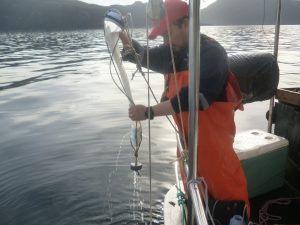Aysén Regional Government finances two red tide projects executed by IFOP
January 12th, 2018 Three important red tide detection projects, which aims to detect any noxious flowering event and promptly alert IFOP Fisheries Development Institute authority is working with Aysén Regional Government and Economy and Small Enterprises Subsecretariat,.
Three important red tide detection projects, which aims to detect any noxious flowering event and promptly alert IFOP Fisheries Development Institute authority is working with Aysén Regional Government and Economy and Small Enterprises Subsecretariat,.
Dr. Leonardo Guzmán, head of IFOP aquaculture research division explained ” Since 2006 IFOP is developing ” Management and Monitoring Program for Red Tides in the Regions of Los Lagos, Aysén and Magallanes “study, which is currently in its XI stage, and from January 2018 ” Management and Monitoring Program for harmful algal blooms and marine toxins in the Pacific Ocean from Biobío to Aysén (I stage) 2018 study, which is one of the program studies, is one of the permanent program held and performed with resources subscribed annually with the Economy Subsecretariat and smaller Size Companies Agreement “. Both cover Aysén region geographic reality, although it first covers this region entire area from Estero Pitipalena and Melinka up north, and to Tortel sector to the south. The other study only contemplates Pacific Ocean coastal sector in the extreme north of this region, understood as far as the Biobío region.
“In Aysén region, projects are being performed on: Affected FANs bivalves Natural Detoxification Transfer. And Transfer improvement of FANs XI region monitoring. Both financed by Aysén Regional Government (GORE).
The first aims to provide reliable and timely information on distribution and abundance of harmful microalgae and the levels of marine toxins in seafood, in order to protect public health and minimize productive activities impacts. While GORE funded studies, one aims to achieve information in field conditions aimed at assessing naturally eliminating toxins from shellfish feasibility and making them suitable for human consumption, and the other, in addition to detecting and evaluating clam banks and other fishing resources, aims to strengthen current development monitoring program in at Aysén region level (the first study).
It is important to point out that the first study mentioned is developed in conjunction with Aysén Regional Ministerial Secretariat, in relation to the country’s official techniques application, to evaluate paralytic, diarrheic and amnestic toxins, which could eventually be present in seafood, “said Guzmán.
Nowadays, all these studies are being channeled through for IFOP Harmful Algal Studies Center (CREAN for its Spanish name), with its three working groups established in Puerto Montt, Puerto Aysén and Punta Arenas.